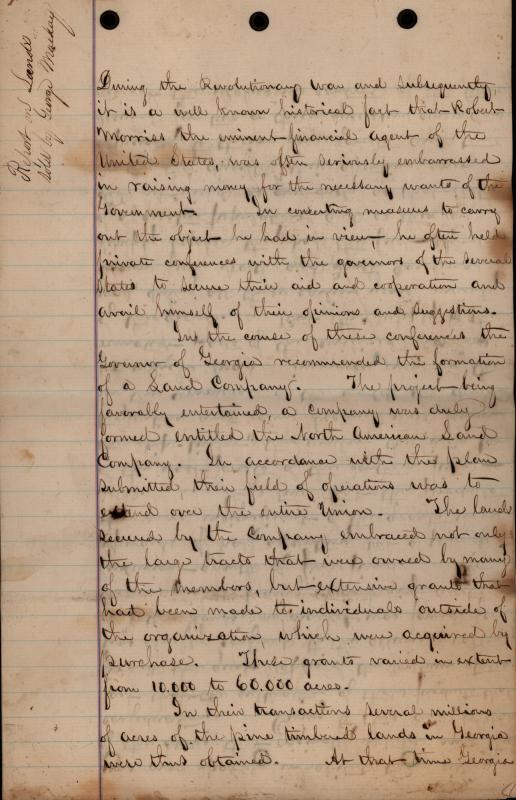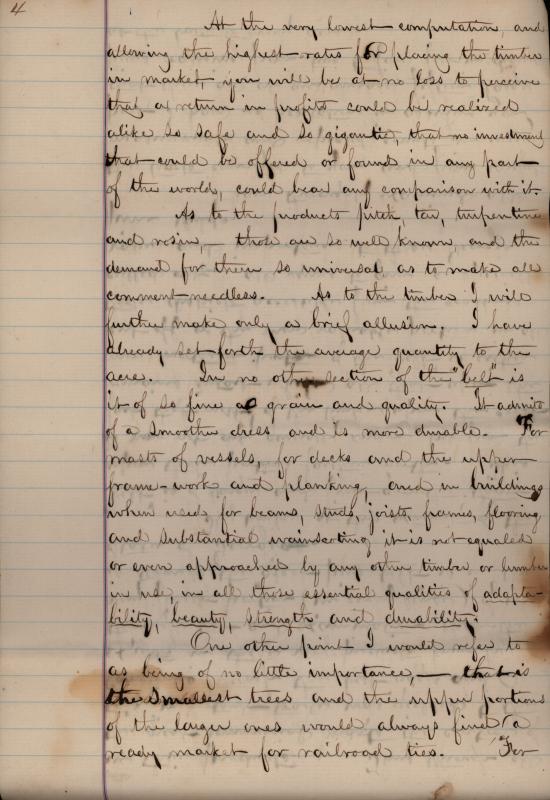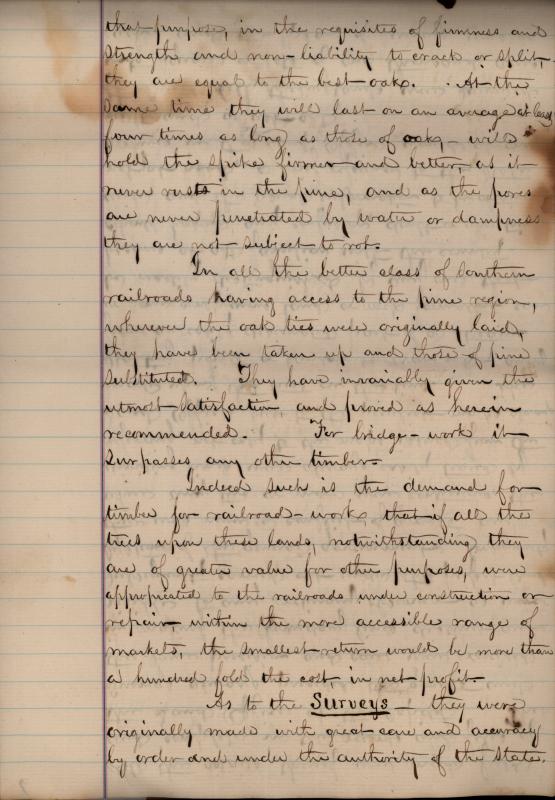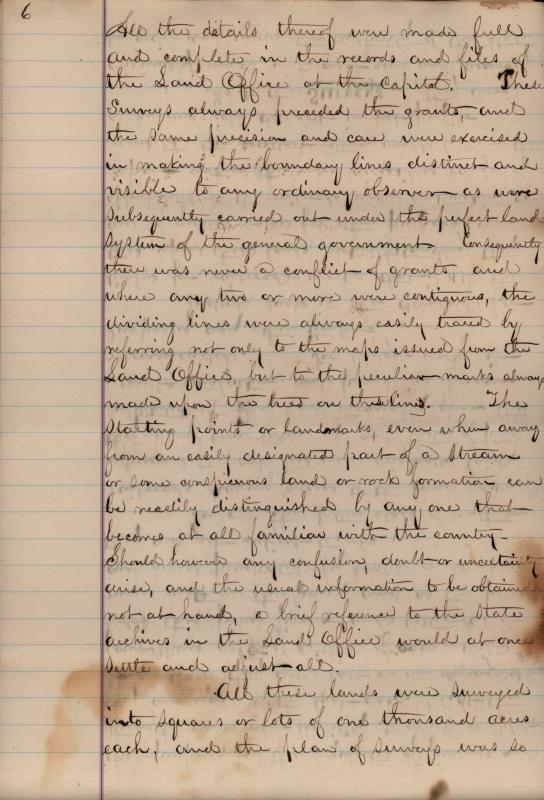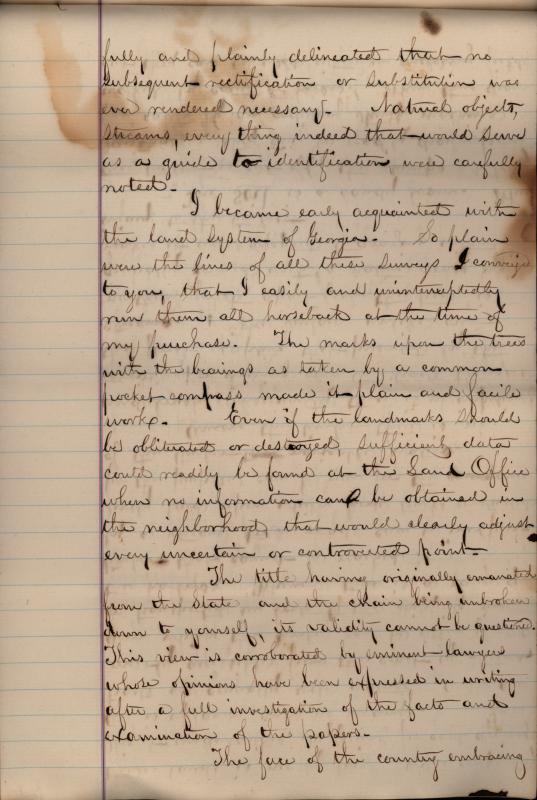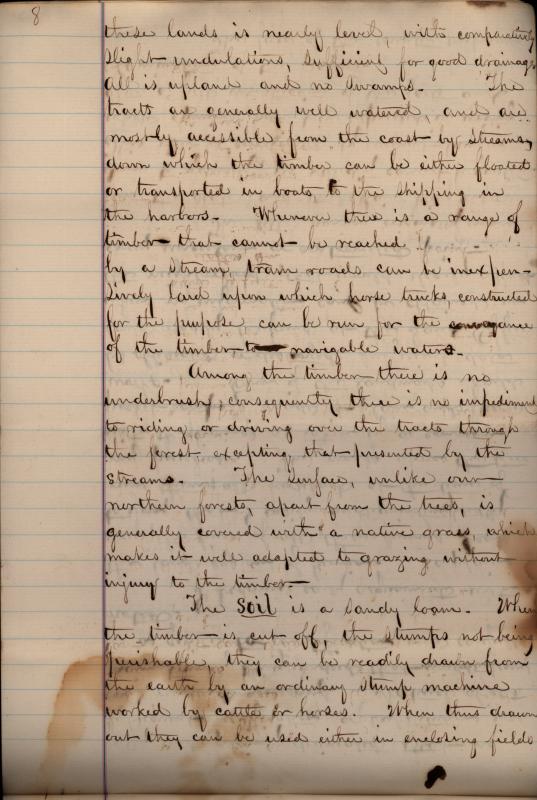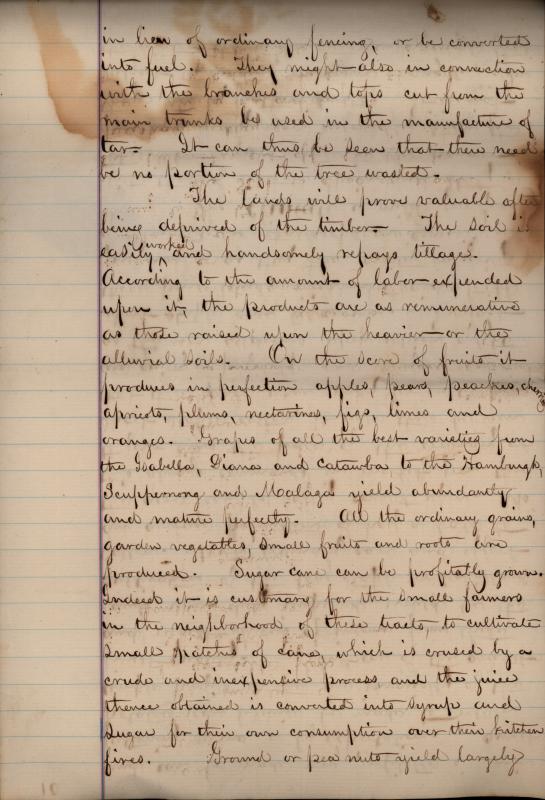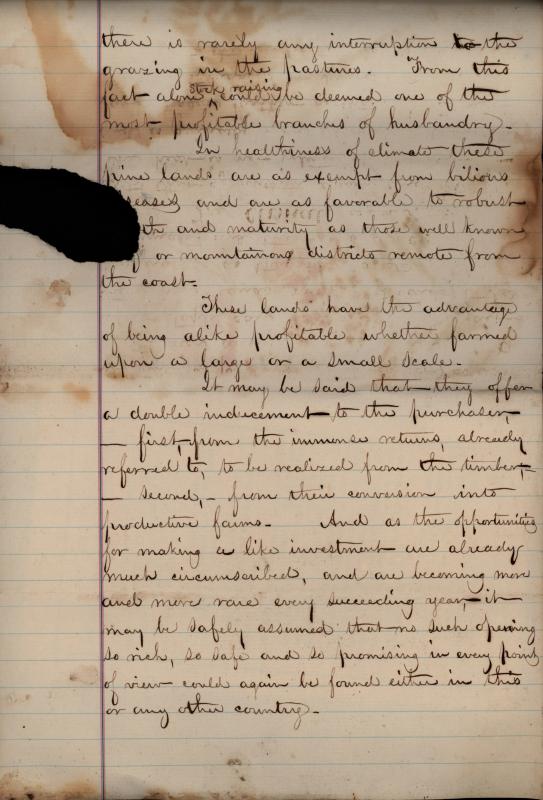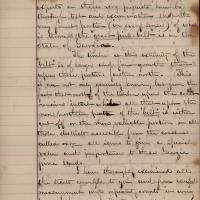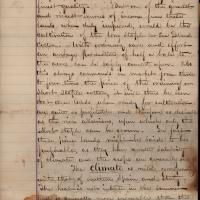-
Title
-
MacKay_Letter_126
-
Description
-
Report on land in Georgia that was either being sold to, or sold by, George MacKay. Unknown writer. No date.
Transcription:
[Written diagonally] Report on Land sold by George MacKay
[page 1]
During the revolutionary war and subsequently, it is a well known historical fact that Robert Morriss the eminent financial agent of the United States, was often seriously embarrassed in raising money for the necessary wants of the government. In converting measures to carry out the object he had in view, he often held private conferences with the governors of the several states to secure their aid and cooperation and avail himself of their opinions and suggestions.
In the course of these conferences the governor of Georgia recommended the formation of a Sand Company. The project being favorably entertained, a company was duly formed entitled the North American Sand Company. In accordance with the plan submitted, their field of operations was to extend over the entire Union. The lands secured by the Company embraced not only the large tracts that were owned by many of the members, but extensive grants that had been made to individuals outside of the organization, which were acquired by purchase. These grants varied in extent from 10.000 to 60.000 acres.
In their transactions several millions of acres of the pine timbered lands in Georgia were thus obtained. At that time Georgia
[page 2]
was more sparsely inhabited than either of the States that originally entered into the confederation. Owing to this and to the fact that the cultivation of those products that formed the great states of the Southern States was chiefly confined to the alluvial valleys or “bottom lands”, no market was found for these uplands bearing their heavy and luxuriant growth of fine pine. For upwards of half a century but a few of the more insignificant of the grants were sold.
It is true that the products of the vast forest of the southern pine - the ship-timber, the lumber, the pitch, tar, turpentine and rosin, became well known in the commerce of the world, the demand for which was immense even in the remotest parts of the civilized portions of the globe. But the supply of these was, during all these earlier years, mainly drawn from North and South Carolina simply because they had the first advantage of a greater population, and as their soil did not yield as generously as that farther south, they directed their attention more especially to their pine forests, and thus secured for two or three successive generations almost the exclusive control of the trade
[page 3]
in their products. Thus through all the great commercial marts the control of this important trade was yielded to the Carolinas through the best judges and experts in these very products knew by thorough test and examination that the very finest portion (in every sense) of what is termed the “great pine belt” is in the state of Georgia.
The timber at this extremity of the “belt” is of larger and finer growth than upon those portions farther north. This is now not only generally known, but from the fact that most of the timber upon the coast remains intact while all that upon the more northern parts of the “belt” is either cut off or the more valuable portion in all those districts accessible from the coast is culled out, all serves to give a special value and importance to these Georgian pine lands.
I have thoroughly examined all the tracts conveyed to you, and from careful measurement and repeated counts in every part I have no hesitation in assuring you that there are on an average fifteen large pines ranging from two to five feet in diameter at the butt, to every acre.
[page 4]
At the very lowest computation, and allowing the highest rates for placing the timber in market, you will be at no loss to perceive that a return in profits could be realized alike so safe and so gigantic, that no investment that could be offered or found in any part of the world, could bear any comparison with it.
As to the products pitch, tar, turpentine and resin, - those are so well known, and the demand for them so universal as to make all comment needless. As to the timber I will further make only a brief allusion. I have already set forth the average quantity to the acre. In no other section of the “belt” is it of so fine as grain and quality. It admits of a smoother dress and is more durable. For masts of vessels, for decks and the upper frame-work and planking, and in buildings when used for beams, studs, joists, frames, flooring and substantial wainscoting it is not equaled or even approached by any other timber or lumber in use, in all those essential qualities of adaptability, beauty, strength and durability.
One other point I would refer to is being of no little importance, - that is the smallest trees and the upper portions of the larger ones would always find a ready market for railroad ties. For
[page 5]
that purpose, in the requisites of firmness and strength and non-liability to crack or split, they are equal to the best oaks. At the same time they will last on an average at least four times as long as those of oaks, - will hold the spike firmer and better, as it never rusts in the pine, and as the pores are never penetrated by water or dampness they are not subject to rot.
In all the better class of southern railroads having access to the pine region, wherever the oak ties were originally laid, they have been taken up and those of pine substituted. They have invariably given the utmost satisfaction and proved as herein recommended. For bridge-work it surpasses any other timber.
Indeed such is the demand for timber for railroad-works, that if all the trees upon these lands, notwithstanding they are of greater value for other purposes, were appropriated to the railroads under construction or repair, within the more accessible range of markets, the smallest return would be more than a hundred fold the cost, in net profit.
As to the surveys- they were originally made with great care and accuracy by order and under the authority of the state.
[page 6]
See the details thereof were made full and complete in the records and files of the Sand Office at the Capitol. These surveys always preceded the grants, and the same precision and care were exercised in making the boundary lines distinct and visible to any ordinary observer as were subsequently carried out under the perfect land system of the general government. Consequently there was never a conflict of grants, and where any two or more were contiguous, the dividing lines were always easily traced by referring not only to the maps issued from the Sand Office, but to the peculiar marks always made upon the trees on these lines. The starting points are landmarks, even when away from an easily designated part of a stream or some conspicuous land or rock formation can be readily distinguished by anyone that becomes at all familiar with the country. Should however any confusion, doubt or uncertainty arise, and the usual information to be obtained not at hand, a brief reference to the state archives in the Sand Office would at once settle and adjust all.
All the lands were surveyed into squares or lots of one thousand acres each, and the plan of surveys was so
[page 7]
fully and plainly delineated that no subsequent rectification or substitution was ever rendered necessary. Natural objects, streams, every thing indeed that would serve as a guide to identification were carefully noted.
I became early acquainted with the land system of Georgia. So plain were the lines of all these surveys I conveyed to you, that I easily and uninterruptedly ran them all horseback at the time of my purchase. The marks upon the trees with the bearings as taken by a common pocket compass made it plain and facile work. Even if the landmarks should be obliterated or destroyed, sufficient data could readily be found at the Sand Office when no information can be obtained in the neighborhood, that would clearly adjust every uncertain or controverted point.
The title having originally emanated from the State and the chain being unbroken down to yourself, its validity cannot be questioned. This view is corroborated by eminent lawyers whose opinions have been expressed in writing after a full investigation of the facts and examination of the papers.
The face of the country embracing
[page 8]
these lands is nearly level, with comparatively slight undulations, sufficient for good drainage. All is upland and no swamps. The tracts are generally well watered, and are mostly accessible from the coast by streams, down which the timber can be either floated or transported in boats to the shipping in the harbors. Whenever there is a range of timber that cannot be reached by a stream, train roads can be inexpensively laid upon which horse trucks, constructed for the purpose can be run for the conveyance of the timber to navigable waters.
Among the timber there is no underbrush consequently there is no impediment to riding or driving over the tracts through the forest excepting that presented by the streams. The surface, unlike our northern forests, apart from the trees, is generally covered with a native grass, which makes it well adapted to grazing without injury to the timber.
The soil is a sandy loam. When the timber is cut off, the stumps not being perishable, they can be readily drawn from the earth by an ordinary stump machine worked by cattle or horses. When thus drawn out they can be used either in enclosing fields
[page 9]
in lieu of ordinary fencing, or be converted into fuel. They might also in connection with the branches and tops cut from the main tops be used in the manufacture of tar. It can thus be seen that there need be no portion of the tree wasted.
The lands will prove valuable after being deprived of the timber. The soil is easily worked and handsomely repays tillage. According to the amount of labor expended upon it, the products are as remunerative as those raised upon the heavier or the alluvial soils. On the score of fruits it produces in perfection apples, pears, peaches, cherries, apricots, plums, nectarines, figs, limes and oranges. Grapes of all the best varieties from the Isabella, Diana and Catawba to the Hamburgh, Scuppernong and Malaga yield abundantly and mature perfectly. All the ordinary grains, garden vegetables, small fruits and roots are produced. Sugar cane can be profitably grown. Indeed it is customary for the small farmers in the neighborhood of these tracts to cultivate small patches of cane, which is crushed by a crude and inexpensive process and the juice thence obtained is converted into syrup and sugar for their consumption over their kitchen fires. Ground or pea nuts yield largely
[page 10]
and can be made profitable either in fattening swine, or by exportation. Sweet potatoes can likewise be made to return ample profits as they are invariably of the finest quality. But one of the greatest and richest sources of income from these lands when duly improved, would be the cultivation of the long staple or Sea Island cotton. With ordinary care and effort an average production of half a bale to the acre can be safely counted upon. As this always commands in market from three to four times the price of the ordinary on short staple cotton, it will thus be seen that these lands when ready for cultivation are quite as profitable and therefore as desirable as the rich alluvions, upon which only the short staple can be grown. In fact these pine lands might be said to be preferable, as they have greater salubrity of climate and the crops are generally surer.
The climate is mild, corresponding with that of southern Spain and Italy. The heat is not intense in the summer and is generally more enjoyable than the same season farther north. It is not subject to sudden or severe changes. In the winter the temperature is so genial that
[page 11]
there is rarely any interruption to the grazing in the pastures. From this fact alone stock raising could be deemed one of the most profitable branches of husbandry.
In healthiness of climate these pine lands are as exempt from bilious diseases and are favorable to robust health and maturity as those well known [hole in paper] or mountainous districts remote from the coast.
These lands have the advantage of being alike profitable whether farmed upon a large or a small scale.
It may be said that they offer a double inducement to the purchaser - first from the immense returns, already referred to, to be realized from the timber - second from their conversion into productive farms. And as the opportunity for making a like investment are already much circumscribed, and are becoming more and more rare every succeeding year, it may be safely assumed that no such opening so rich, so safe and so promising in every point of view could again be found either in this or any other country.
-
Identifier
-
MacKay_Letter_126.1-11.jpg
-
Creator
-
Kristen Walker
-
Subject
-
Prospectus
-
Publisher
-
Izzy Moyer; Kristen Walker; Jill Johnson; and Renee Guerin
-
Date Created
-
2023.10.30
-
Type
-
Administrative Records
-
Prospectus
-
Format
-
.jpg
-
Medium
-
Paper
-
Rights Holder
-
Genesee Country Village & Museum
-
Rights
-
Genesee Country Village & Museum creates opportunities for material, object, and place availability from their collections and location accessible to the public for personal and educational research purposes pursuant to U.S. Copyright Law. Within the stipulations of the museum and related rights legislation that applies to your use, it is your responsibility to obtain permission from the copyright holder to publish or reproduce images in print or electronic form; and, it is strictly prohibited for commercial use without prior communication and agreement with the institution first.
